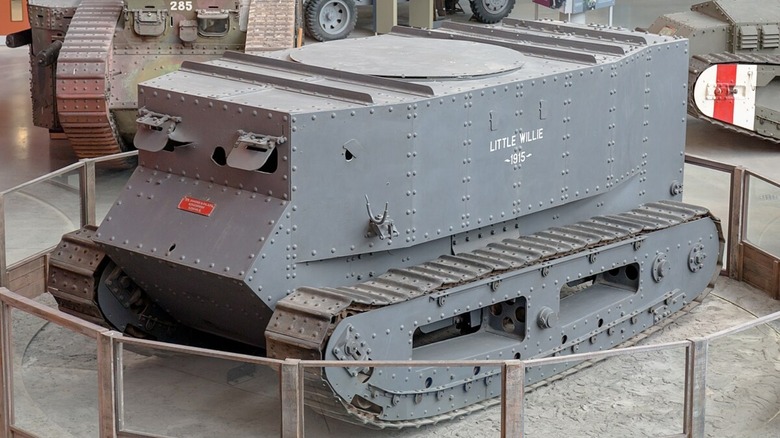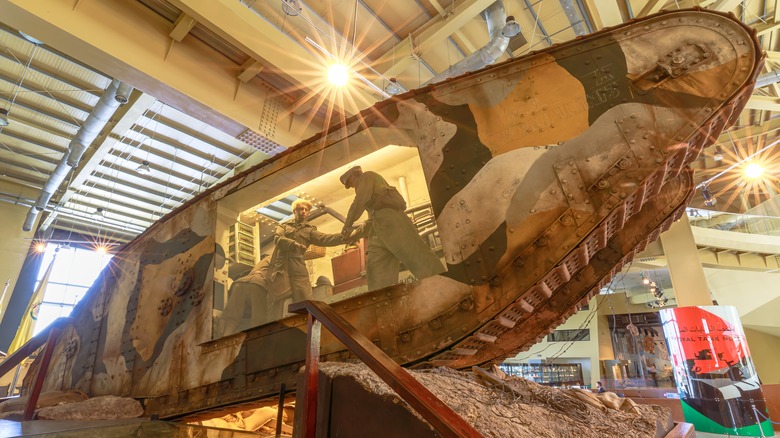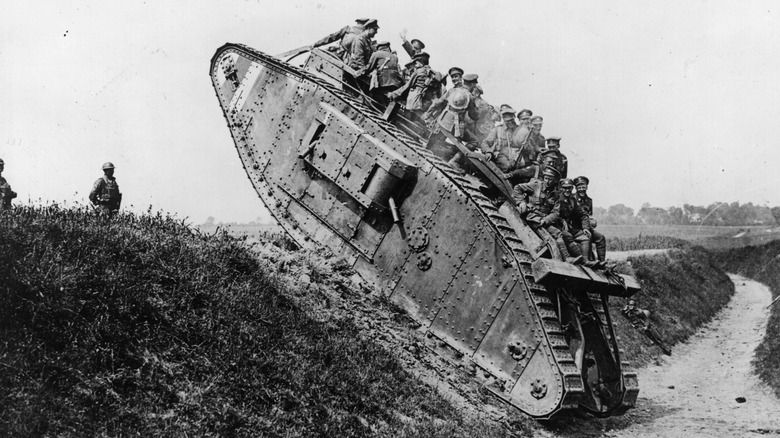The Birth Of The Tank: How Necessity Sparked Innovation In WW1
To be a great commander is to be a great leader. Tactical nous, charisma, receptiveness and all the other invaluable traits all largely boil down to one thing: The ability to see an issue or potential issue and to determine how best to counteract it using the resources available. In warfare, hundreds, thousands, and ultimately millions of lives can depend on somebody having just that ability. Even the sharpest and most capable of us can't achieve our aims without the right tools, and for the British in World War I, a very special tool was needed. It would turn out to be the tank.
Tanks have become inextricably linked with warfare in popular culture — great, armored vehicles rolling forward on tracks into battle. Over a century later, it's difficult to imagine it was once a struggle to develop the tank. But the impact the very first tank had during World War I would have in shaping the future of combat can't be overstated.
This is the story of the struggle to develop a wonder weapon that could help overcome the unique challenges of trench warfare, how the pressure of operating with limited wartime resources shaped that struggle, and the major players in the effort to bring about the birth of the tank.
The situation that sparked the invention of the tank
During the First World War, the Allied and Central Powers committed extraordinary resources to the fight, but could only stretch manufacturing capabilities, transportation systems and soldiers so far. This meant that these resources had to be focused on key strategic locations.
The result of frequent assaults and fortification of important locations was stalemate associated with trench warfare. Positions across the battlefields had a stretch in between sides that came to be referred to as no man's land. To attempt to capture an opposing trench was an enormously dangerous endeavor, generally forcing the attacking troops to expose themselves completely to gunfire. As the war continued, strategies such as night raids were pursued in an attempt to minimize such risks.To attempt to tackle this issue, trenches were created with certain protective measures in place for the defenders, such as complicated angular designs that hampered the process of invaders who reached opposing trenches.
How, though, could lines be broken without attacking soldiers dying in droves? A big, heavy, armored transport that could penetrate defenses and protect from gunfire on the journey would be ideal. This line of thinking led to the creation of an organization dedicated to building such a machine.
The arrival of the landship
Sloped trenches were a nightmare. Elaborate barbed wire defenses were time-consuming obstacles at best, and lethal, insurmountable dangers at worst. A super weapon that could force its way through such a barrier while also absorbing the ire of the enemy, would have been absolutely ideal for these harrowing circumstances.
The British military, accordingly, assigned high priority to the matter. Winston Churchill, who would go on to lead the nation through World War II, was First Lord of the Admiralty in 1915. In that capacity, he was instrumental in establishing the Admiralty Landship Committee.
The Committee was tasked with devising a vehicle capable of breaking the stalemate created by the trenches and barbed wire, to carve a path for the infantry to follow. It faced a truly monstrous task: Crossing trenches was an effort as perilous for vehicles as it was for infantry, with its hazards, awful unevenness as a result of shelling, and otherwise inhospitable terrain. Armored cars used earlier in the war simply weren't up to the task, and an experiment with steam rollers saw the great machines hampered by mud. The Committee formed early in 1915 and was led by Director of Naval Construction Eustace Tennyson D'Eyncourt. By July that year, it tried out a very unique armored vehicle combining parts from a tractor and an armored car, utilizing on tracks. As primitive and impromptu as it was, it test showed the potential for what would become a tank.
The mystery of the very first tanks
Before big tanks came the iconic 18-ton Little Willie in 1915. Necessity was the driving force for Willie and the experimental tractor-car mash-ups that preceded it. There wasn't a precedent for a military "landship" at the time, so William Foster & Co was tasked with building it. It stood at nine feet tall, 26 feet long, and nine feet wide. A rear-mounted 13-liter 6-cylinder 105 hp Daimler-Knight engine powered it.
When developing secret weapons that could potentially be pivotal in the outcome of a war, it's crucial to ensure that the opposite side doesn't get wind of it. For this reason, the name of "tank" had a dual origin: It described the water tank-esque form of the first models, while giving nothing away about the nature of the machines.
Fellow British soldiers knew essentially nothing of their existence if they wouldn't be using them. One, Horace Calvert, told the Imperial War Museums' "Voice of the First World War" podcast that his squadmates' first view of tanks was "on the roadside covered with tarpaulin sheets ... when we asked what it was, the simple reply was, 'Tanks.' We naturally assumed water tanks and we'd no reason to think otherwise."
[Image by Morio via Wikimedia Commons | Cropped & resized| CC BY-SA 4.0]
The development of the World War I tank
The Mark I was the first official tank used in battle. It was a 28-ton model with a crew of eight and pair of six pound guns, backed by Hotchkiss 7.62mm machine guns. Its 12 mm armor meant that it was far more capable than the primitive models that preceded it. had a relatively short life, with only 150 models being made. The deadly concept had such potential, however, that the British were keen to develop it further. In April of 1917, the Mark II tank hit the field at the Battle of Arras, during which British forces supported a French offensive.
This model was capable of moving at 3.7 mph, but it was also flawed, lacking true armor. The reason for this is another fascinating element of the creation of tanks in warfare: It wasn't enough to simply develop effective tanks, because they'd get nowhere without crews. The British answer to this was to develop simpler tanks for training purposes. These were the Mark IIs, 50 of which were developed to be used to teach tankers.
The British army intended to develop the Mark IV as a true follow-up to the original, with plans to build 2,000 of them, but they weren't nearly ready when more tanks were needed at the Battle of Arras in 1917, and so the British improvised and sent their training models into battle.
Other nations' tanks and their responses to them
Britain wasn't the only nation to field tanks, of course. The French Schneider C.A.1 was France's first tank, with 121 of the 400 ultimately built appearing on the battlefield in April 1917 at Berry-au-Bac. Its primary weapon was a 75mm gun. It would later be joined by the formidable Renault FT.
As the war wore on, then, the German army was forced to develop its own response. The Mauser Tank-Gewehr was a unique and cumbersome rifle from 1918 that fired a single monstrous shot: A 13mm projectile that could tear through a tank's armor. Tanks at the time were very vulnerable to artillery fire.
The first and only German tank of World War I, the A7V, was a sophisticated model that was faster and better-protected than the Allied models that faced it. Capable of 9 mph, it was quite a speedster for a 33-ton beast, and was carefully designed so that its tracks were incorporated within its armored shell. It even had suspension, unlike its Allied counterparts. It also packed considerable power in the shape of a 57mm gun backed up by a sextet of MG 08 machine guns.
The A7's shortcoming was that it arrived so late in the war, in 1918 that less than two dozen of them were completed before its end.
How did tanks perform in World War I?
In World War II, tanks were absolutely instrumental in the overall progress of the conflict from start to end. But they weren't much to behold at the beginning of World War I. The early models had mechanical struggles and issues tackling the terrain. Their debut in battle, which took place in France at Flers-Courcelette in mid-September 1916, was marked by mechanical issues, to the extent that, of 49 British Mark Is that were set to be deployed in the Allied attack, 40 were knocked out by either opposing fire or their own faltering mechanics. This isn't to say, though, that the Mark I wasn't a monstrous weapon.
A 28-ton model with a crew of eight and pair of six pound guns, backed by Hotchkiss 7.62mm machine guns, its 12 mm armor. The Mark I would soon undergo a series of modifications, including refinement of the tracks and braking systems to better suit the machines' ultimate purpose: To overcome trench fortifications and help break deadlocks.
This led to the Mark IV, with armor almost half an inch thick and a pair of six-pound guns in its male configuration. 1222 of them were built, and their appearance at the Battle of Cambrai in November 1917 in huge numbers (476 in total were used there) marked a first for warfare. Five months later, Mark IVs began engaging A7V tanks, ushering in a new era of war.






